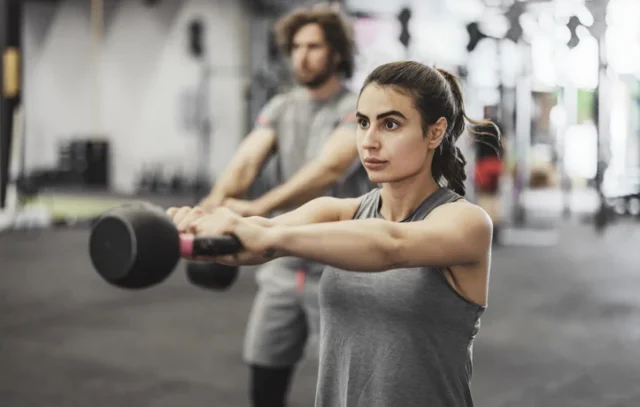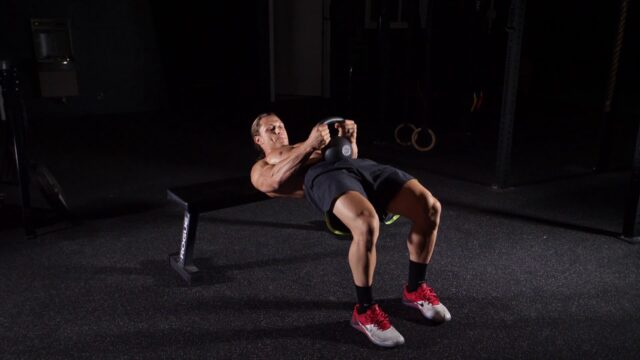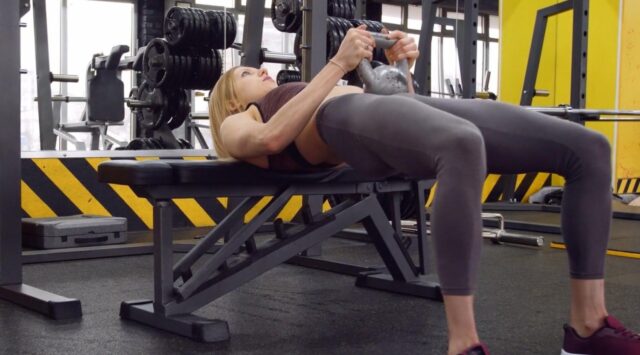
Are you getting bored with your usual workout routine? Are you longing for a fitness challenge that tests your strength and gets your heart pumping? It might be time to shake things up by adding kettlebell thrusts to your fitness plan. These dynamic, full-body movements can breathe new life into your workouts and offer many benefits that’ll leave you feeling stronger, fitter, and more energized than ever before.
In this article, we’ll dive into kettlebell thrusts, covering everything from their fantastic advantages to when and how to incorporate them into your fitness routine.
What is a Kettlebell Thrust?
Before we get into the details, let’s talk about a kettlebell thrust. This exercise is a mix of a kettlebell squat and a press. Begin with the bell at chest height (racked position), then squat down and use the momentum to stand up explosively, pressing the kettlebell overhead. This dynamic exercise engages multiple muscle groups, including the quads, glutes, shoulders, and core.
What are the benefits?

This is not your average exercise – it benefits those looking to boost their overall fitness. Incorporating kettlebell thrusts into your routine can help you achieve different fitness goals. Here are some key advantages:
1. Full-Body Workout
Thrusts engage multiple muscle groups in your body, making them an excellent full-body exercise. They target the quads, glutes, hamstrings, shoulders, and core, promoting balanced muscle development.
2. Strength and Power
These thrusts require explosive power generation from your lower body, transferring it to your upper body. This increases strength and power, especially in your legs, hips, and shoulders.
3. Cardiovascular Conditioning
These thrusts are high-intensity and raise your heart rate quickly. Adding them to your routine can improve cardiovascular fitness, making them great for endurance and calorie burning.
4. Functional Fitness
They mimic real-life movements, making them highly practical. The squatting and pressing actions can enhance your ability to perform everyday tasks efficiently.
5. Core Strength
During the exercise, your core muscles are essential in stabilizing your body. This exercise helps strengthen your core, improve posture, and reduce the risk of back pain.
6. Explosive Power

If you’re into sports or activities that require quick bursts of energy, thrusts are perfect for enhancing explosive power.
7. Improved Coordination
Coordinating the squat and push movements tests your coordination and balance, which can lead to improved body control over time.
8. Efficient Time Use
This exercise works for multiple muscle groups simultaneously, making them time-efficient. It is ideal for those with busy schedules who want effective workouts in less time.
9. Variety and Plateau Breaking
If you’ve hit a plateau in your fitness routine, adding kettlebell thrusts can stimulate your muscles, helping you overcome stagnation and progress.
When to Incorporate Kettlebell Thrusts
Incorporating kettlebell thrusts for variety and challenge in your workout requires strategic timing to optimize benefits and reduce injury risk. Here are key considerations:
1. Master the Fundamentals
Before attempting this, ensure you’re proficient in basic exercises like swings, goblet squats, and kettlebell presses. These movements help build the strength and mobility needed for kettlebell thrusts.
2. Strength and Conditioning Level

Kettlebell thrusts demand strength and cardiovascular endurance, so it’s best to incorporate them at an intermediate or advanced fitness level. Beginners should focus on building strength and conditioning with more straightforward exercises first.
3. Variety and Plateau Breaking
If you’ve hit a plateau in your current routine or want to add variety, kettlebell thrusts can help. They can challenge your body in new ways and help you break through plateaus.
4. High-Intensity Interval Training (HIIT)
Kettlebell thrusts are excellent for HIIT workouts. If you’re already doing HIIT, consider adding them for a high-intensity boost.
5. Functional Strength and Athletic Performance
Athletes and those looking to improve functional strength, power, and explosiveness can benefit from kettlebell thrusts, especially when aiming to enhance performance in sports like basketball, soccer, or martial arts.
6. Time-Efficient Workouts
If you have limited time, kettlebell thrusts are an excellent choice. They work multiple muscle groups simultaneously, making them suitable for quick, full-body workouts.
7. Consult with a Trainer
If you’re new to kettlebell training, it’s wise to consult a certified fitness trainer. They can assess your fitness level, teach proper form, and create a plan to incorporate thrusts safely.
8. Recovery and Rest Days
Use kettlebell thrusts for active recovery workouts for a break from high-impact activities. Allow your muscles time to recover, especially when intensely targeting the same muscle groups.
Things to Consider
When adding kettlebell thrusts to your workout routine, remember these critical factors:
1. Proper Form and Technique
Correct form is crucial to avoid injuries, especially in the lower back and shoulders. Learn and practice proper technique before doing kettlebell thrusts.
2. Start with the Right Weight
Begin with a weight that suits your current fitness level. Starting too heavy can compromise form and increase injury risk.
3. Warm-Up and Mobility

Always warm up before your workout to prepare muscles and joints. Use dynamic stretches and mobility exercises to enhance flexibility and prevent injury.
4. Gradual Progression
Increase the weight gradually once you’ve mastered proper form with a lighter kettlebell.
5. Breathing Technique
Pay attention to your breathing, inhaling during the squat and exhaling during the press.
6. Repetition and Sets
Adjust the number of repetitions and sets based on your goals for strength and power or cardiovascular conditioning.
7. Rest and Recovery
Give your muscles time to recover between intense kettlebell thrust sessions targeting the same muscle groups.
8. Listen to Your Body
If you experience discomfort or pain, rest and seek medical advice if necessary.
9. Warm-Down
After your kettlebell thrusts, perform a cool-down routine with static stretching and mobility exercises.
Conclusion
Kettlebell thrusts are a fun and challenging exercise that can help you become in great shape. They are a practical and versatile option for anyone looking to improve their strength, and cardiovascular health, or break through a fitness rut. Never rush your progress, listen to your body, and let lousy form derail your training.
Try kettlebell thrusts to shake up your workout routine and feel a new rush of excitement. With time, effort, and direction, you may become a more robust, fitter, and more energized version of yourself. Put your fitness to the test with the kettlebell thrust









